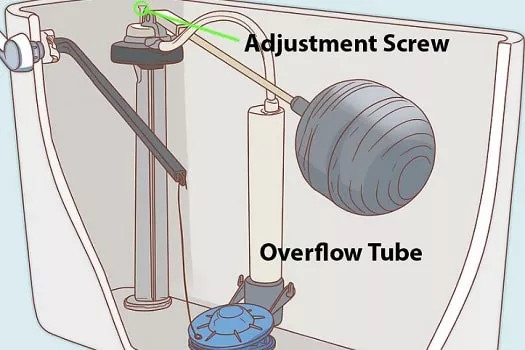Have you ever found yourself standing in the bathroom, listening to the continuous sound of running water from your toilet? It’s not just annoying; it’s wasteful and can lead to higher water bills.
But don’t worry; the solution might be simpler than you think. By adjusting the toilet float, you can easily fix this issue and stop the leak. This task might sound intimidating at first, but with a little guidance, you’ll discover it’s not just for the pros.
Adjusting a toilet float is a straightforward process that can save you money and prevent future plumbing issues. You have the power to take control and tackle this common household problem on your own. Ready to learn how to make this simple adjustment and eliminate that pesky noise for good? Let’s dive in, and soon, you’ll have your toilet running smoothly in no time.
Table of Contents
Tools And Materials Needed
To fix a toilet float, gather a few simple items. A screwdriver is often needed. This helps to loosen or tighten screws. A wrench might be useful. Some floats need a wrench to adjust. Don’t forget a towel. It helps to keep the area dry. A bucket is handy too. It catches any extra water. You might also need replacement parts. Sometimes, floats or valves are old or broken. Having these ready makes fixing easier.

Credit: www.wikihow.com
Identifying Float Types
The ballcock float is a simple type of toilet float. It has a large, round ball attached to a long arm. This arm connects to the fill valve. The ball floats on top of the water. As water rises, the ball moves up. This movement shuts off the water flow. It’s important to check the ball for cracks. Cracks can cause leaks. Make sure the arm is not bent. A bent arm can cause water to keep running.
The cylinder float is a modern design. It is also called a cup float. This float is a small, cylindrical shape. It slides up and down on the fill valve. The float rises with the water level. This action stops the water flow. Cylinder floats are compact. They save space in the tank. Check for any blockages. Blockages can prevent the float from moving. Ensure the float moves smoothly.
Safety Precautions
Always turn off the water supply before starting. This prevents any accidents or water spills. Use a dry towel to wipe the toilet tank. This keeps the area clean and dry. Ensure the floor around the toilet is dry too. This prevents any slipping or falls.
Wear gloves to protect your hands from germs. These also help in gripping tools better. Ensure your tools are ready and within reach. This saves time and avoids unnecessary movements. Keep your working area well-lit. This helps you see clearly and avoid mistakes. Follow these precautions for a safe and easy adjustment.
Shutting Off Water Supply
Begin by locating the water supply valve. It is usually found behind the toilet. Turn the valve clockwise to stop the water. Make sure the water is completely off. This prevents any water from spilling. Check the tank to ensure it is empty. If not, flush the toilet to empty it. Doing this makes adjustments easier.
After shutting off, observe the float inside the tank. The float controls water level. If the float is too high, the water will overflow. Lowering the float stops overflow. Adjust the float gently. It should move freely. If stuck, check for any obstructions.
Adjusting Ballcock Float
First, lift the toilet tank lid. Look inside. You’ll see a long rod. This rod connects to the ballcock float. The adjustment screw is near the rod. It’s usually on top. You might need a screwdriver. The screw changes the float height. Be careful. The screw is small. Don’t lose it!
Turn the screw gently. Turning clockwise lowers the float. This reduces water in the tank. Turning counterclockwise raises the float. This adds more water. Adjust slowly. Check water level after each turn. Too much water can overflow. Too little won’t flush well. Find the right balance.
Adjusting Cylinder Float
The adjustment clip is on the float arm. It helps set water levels. First, look inside the toilet tank. Spot the cylinder float. Find the small clip on the side. It’s usually plastic or metal. This clip is important. It helps to adjust the water level. Always handle it gently. Breaking it can cause issues. It’s easy to spot. Just look carefully.
To adjust, pinch the clip gently. Slide it up or down. Moving up means more water. Moving down means less water. This helps conserve water. Always check the new level. Flush to test it. Adjust again if needed. It’s simple and quick. Just be careful not to break it. Repeat until satisfied.
Checking Water Level
The water level in the toilet tank is crucial. A low or high level can cause issues. First, remove the tank lid carefully. Check if the water reaches the marked line inside. This line shows the correct water level. If water is below the line, it might not flush well. If above, it can waste water. Adjusting the toilet float can fix this. Look for the float inside the tank. It controls the water level. Older toilets might have a ball float. Newer ones use a cup float. Both need adjustments if the water level is wrong.
For a ball float, turn the adjustment screw. This screw is on the fill valve. Turn clockwise to lower the water level. Turn counter-clockwise to raise it. For a cup float, squeeze the clip on the float rod. Slide it up or down to adjust the level. Always ensure the water stops at the correct line. This keeps the toilet working well and saves water.
:max_bytes(150000):strip_icc()/adjusting-types-of-toilet-ballcocks-1824861-09-91d82c57bfd042aaa67346e60634f872.jpg)
Credit: www.thespruce.com
Testing The Flush
Start by flushing the toilet. Watch how the water moves. See if the water fills the bowl properly. If not, there may be a problem. The float might be set too high or too low. A high float leads to too much water. A low float gives too little water. Check the handle. Make sure it moves easily. If it sticks, it might need fixing. Listen for strange noises. Gurgling or hissing sounds signal issues. These might come from the float or the fill valve. Adjusting these can help. The tank should fill smoothly. If it doesn’t, the float needs checking. A well-set float ensures a good flush. This saves water and keeps the toilet working well.
Troubleshooting Common Issues
Adjusting the toilet float can solve water level issues. Ensure the float is set properly to prevent overflows or insufficient flushing. Simple tweaks often correct these problems, restoring efficient toilet function.
Float Not Staying In Place
Toilet floats help control water levels. If the float does not stay put, check the rod. The rod might be bent or loose. Tighten the screw on the float arm. Bend the rod gently if needed. Look for obstructions that block the float. Remove anything in its way. Secure the float properly. The float should move freely.
Water Level Too High Or Low
Water levels affect toilet flushing. Adjust the float to fix levels. For high water, lower the float. Turn the adjustment screw counterclockwise. For low water, raise the float. Turn the screw clockwise. Check after adjustments. Ensure the water stops at the correct line. Test flush after changes. Repeat if levels are still off.

Credit: www.plumbersstock.com
Frequently Asked Questions
How Do I Adjust The Toilet Float?
To adjust the toilet float, locate the float inside the tank. If it’s a ball float, bend the rod gently. For a cup float, slide it up or down the rod. Ensure the float is positioned properly to control the water level, preventing overflows or insufficient flushing.
What Tools Are Needed For Toilet Float Adjustment?
Adjusting a toilet float usually requires no tools. However, a screwdriver may be needed if your float is secured with screws. Most modern floats are easily adjustable by hand. Always check the manufacturer’s instructions for specific guidance on adjusting your particular toilet model.
Why Is Toilet Float Adjustment Important?
Correct float adjustment ensures efficient flushing and prevents water wastage. An improperly adjusted float can lead to either overflows or weak flushes. Maintaining the right water level saves money on water bills and avoids potential damage from excess water in the tank.
How Can I Tell If My Toilet Float Is Faulty?
Signs of a faulty float include continuous running water or weak flushing. Inspect the float for cracks or wear. If adjusting doesn’t resolve the issue, you might need to replace the float. Regular maintenance helps identify problems early and ensures the toilet operates efficiently.
Conclusion
Adjusting the toilet float is simple and effective. It helps save water. This small task prevents toilet leaks and overflows. Start by locating the float inside the tank. Adjust it by turning the screw or bending the rod. Test your adjustment by flushing.
Repeat until the water level is correct. This ensures your toilet works efficiently. Regular checks can prevent future problems. Keep your tools handy for quick adjustments. Proper float adjustment promotes water conservation and reduces bills. Remember, a well-maintained toilet is key.
Happy flushing!






